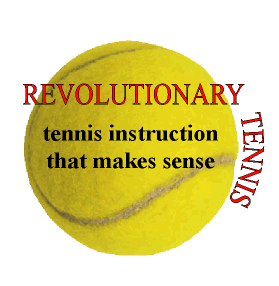Revolutionary Tennis |
||
Tennis Instruction That Makes Sense |
||
Head-On
FOOTWORK This alleged "footwork" ideology is repeated over and over, and here it is again. If you heed this advice your footwork suffers. I think this appeared in the supplement that arrives with TENNIS magazine, I can't remember, I tossed mine. Tip of the Week: Baby Steps to Better Footwork By Tony Lance, TENNIS Magazine, 1/26/04 Some coaches believe that a player's footwork--the ability to move around the court and get into position for the ball--is the single biggest determinant of success on the tennis court. They may be right. Rarely has a player who didn't cover the court well reached the top of the pro ranks. And it's just as important at the recreational level. Although successful court coverage has a genetic component--some of us are naturally speedier than others--there's one thing everyone can do, aside from becoming more fit, that will immediately improve their footwork: learn to take small steps. Many players move around the court as if they're running on a track. They use big, loping strides to go back and forth and side to side. That's fine if you're running a 10K, but it's not so good for tennis. Instead, try to take lots of little steps, especially in the final moments before you hit the ball. Taking adjustment steps, as they're sometimes called, become especially important when you're playing on clay or in the wind, where the bounce and movement of the ball is less predictable. Need further proof that small steps are key in tennis? While watching the Australian Open on TV this week, close your eyes and listen to the sounds made by the player's shoes. You'll get the idea. BREAK IT DOWN Improvement = footwork = "learn to take small steps." How many? "...lots..." What kinds of steps? "...little steps..." When? "Especially in the final moments before you hit the ball." These are also referred to as "adjustment steps." "Proof... of these adjustment steps = "...listen to the sounds made by the player's shoes." I rarely have a single student who moves "around the court as if they're running on a track" using "big, loping strides back and forth and side to side." Wow! Side to side loping strides! Gotta see that one. Probably at a zoo. What I do correct is the angle of approach a student uses to move forward into the ball. Said angle is often off a bit, and the correction lies in asking the student to step more in a forward direction as opposed to over to the side fence. The resulting change corrects the angle of movement but will be observed by the uninitiated as "taking a smaller step." Am I asking the student to take a smaller step due to their loping stride? Absolutely not. Adjustment steps are steps first, not small steps. As explained in Step 2, adjustment steps are based on a bipedal footwork pattern, they simply are regular steps made smaller, they do not exist in and of themselves. You can't have a regular footwork pattern of regular steps and then another pattern of small adjustment steps. One is the parent. You can't ask an athlete to move to a ball or target taking adjustment steps. An athlete moves explosively and at the end of the routine s/he slows down and adjusts their regular running pattern as needed. You can not "take lots of little steps, especially in the final moments before you hit the ball" and be successful or balanced. "Lots" implies three or more steps, and no one should ask you to take three tiny or adjustment steps before you hit the ball. Gee, not only do you have enough to think about but your own kinesthetic sense can handle this. If your timing is a bit off adjust that last step one way or another. Just the last step. A word about sneaker noise and how this does not "prove" Tony Lance's thesis about footwork. The more I move the more I need to slow down to stop on a dime, the faster I run the harder it becomes to do this. Hence the sneaker noise, we put the brakes on! Scree-eech! I am not thinking about working in adjustment steps in my footwork, and neither should you. At the end of hustling to the ball I think about retaining my balance and not about adjusting my steps. Adjustment steps happen because of larger concerns. You don't have long, loping strides, and if your footwork model becomes one where you take lots of small adjustment steps you will be late getting to the ball and your whole game will suffer. I challenge you to get moving to the ball faster, better. How? By taking long strides to begin with, using a rhythmic pattern as outlined in Step 2. Then slow down before you hit it so you don't run into the ball and you're giving yourself the best chance to hit a good shot. |
||
|
|
||||||||||||||||||||||||||||||||||||||||||||||||||||||||||||||
